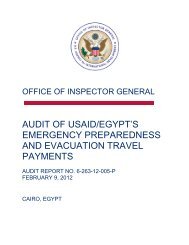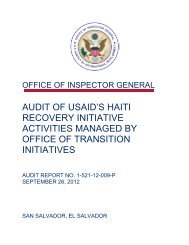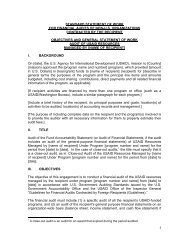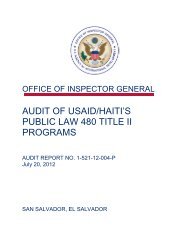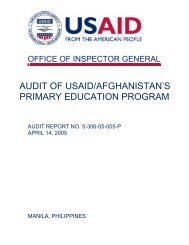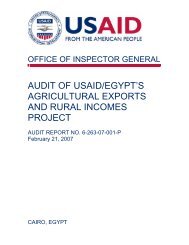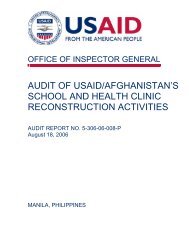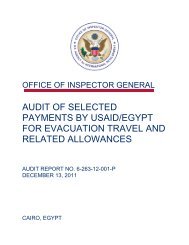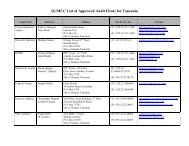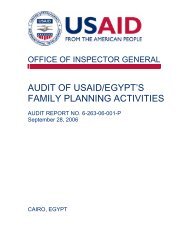USAID OIG Afghanistan and Pakistan Oversight Report, April-June ...
USAID OIG Afghanistan and Pakistan Oversight Report, April-June ...
USAID OIG Afghanistan and Pakistan Oversight Report, April-June ...
- No tags were found...
You also want an ePaper? Increase the reach of your titles
YUMPU automatically turns print PDFs into web optimized ePapers that Google loves.
The audit found that the program had made progress in capacity building in selected Afghan ministries,identified defective <strong>USAID</strong>-built structures, <strong>and</strong> provided engineering oversight for mission constructionprojects.In support of its first goal, the program provided the Afghan Government with additional capacity. Technicalconsultants hired under the program assisted Ministry of Mines personnel in preparing a proposal for therehabilitation of gas fields to generate electrical power for the country. Meanwhile, at the Ministry of PublicWorks, program advisers initiated the development of a pilot program to teach ministry staff how toimplement <strong>and</strong> monitor road construction projects <strong>and</strong> provide them with a more efficient means ofmanaging <strong>and</strong> maintaining roads in the future. At the Ministry of Energy <strong>and</strong> Water, the program contractorprovided a transboundary water-rights adviser to help the ministry develop water policies for negotiationswith neighbors in other countries.With regard to the second goal—evaluating <strong>and</strong> identifying <strong>USAID</strong>-built structures that did not meet seismicst<strong>and</strong>ards—the program was successful in establishing a process for identifying structures that were notearthquake resistant. The mission had a database of 1,474 <strong>USAID</strong>-built structures, but the database was notcomplete. As of October 2009, the program had completed preliminary assessments of 468 of thesestructures <strong>and</strong> detailed structural seismic evaluations of 35. At that point, the program had found 15structures to be unsafe for occupancy.With regard to the third goal, of providing quality assurance <strong>and</strong> engineering oversight on <strong>USAID</strong>construction projects, the program had succeeded in providing these services for projects initiated by themission’s Office of Infrastructure, Engineering <strong>and</strong> Energy. However, the mission had not been so successfulin providing quality-assurance services for construction projects initiated by other program offices in themission.Despite the program’s progress in addressing its three main goals, it had serious issues to address. The mostcritical issue was to identify the many defective structures remaining among the estimated 1,474 missionbuiltstructures. The total number of defective structures was to be determined with the completion of theremaining preliminary assessments <strong>and</strong> any subsequent detailed seismic evaluations. The missionanticipated that the contractor would complete 200 seismic evaluations by the end of the contract. Inaddition, significant defects in five buildings reported in a prior Office of Inspector General audit report(“Audit of <strong>USAID</strong>/<strong>Afghanistan</strong>’s Accelerating Sustainable Agriculture Program,” <strong>Report</strong> No. 5-306-08-009-P,August 8, 2008) had yet to be corrected.Unless defective structures are identified <strong>and</strong> repaired or rebuilt, a catastrophic earthquake could destroythem <strong>and</strong> cause many injuries <strong>and</strong> deaths.Audit of <strong>USAID</strong>/<strong>Afghanistan</strong>’s Building Education Support Systems for Teachers Project (<strong>Report</strong> No. 5-306-10-006-P, January 29, 2010)Almost 4 years into a $94 million, 5-year contract with Creative Associates International Inc. to implement<strong>USAID</strong>’s Building Education Support Systems for Teachers project, <strong>OIG</strong>’s audit concluded that the projectwas making progress in helping to improve the quality of education in <strong>Afghanistan</strong> but had not achieved itstwo main goals: improving teaching through teacher training, <strong>and</strong> institutionalizing ministry structures <strong>and</strong>systems that support high-quality teaching.<strong>USAID</strong> <strong>OIG</strong> <strong>Afghanistan</strong> <strong>and</strong> <strong>Pakistan</strong> <strong>Oversight</strong> <strong>Report</strong> 83



